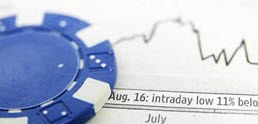 The phrase blue chip stock was coined by Oliver Gingold of Dow Jones in the early 1920’s. Back then, a blue chip stock simply meant a high-priced stock, a reference to how many poker establishments used the color blue for their most valuable chip. According to Dow Jones folklore, Gingold was watching the stock ticker at a brokerage firm (that would eventually become Merrill Lynch) together with Lucien Hooper of W.E. Hutton & Co. Noticing how several companies had shares selling for $200 or $250 a share or more, Gingold told Hooper that he intended to go back to the office to write “about these blue-chip stocks”.
The phrase blue chip stock was coined by Oliver Gingold of Dow Jones in the early 1920’s. Back then, a blue chip stock simply meant a high-priced stock, a reference to how many poker establishments used the color blue for their most valuable chip. According to Dow Jones folklore, Gingold was watching the stock ticker at a brokerage firm (that would eventually become Merrill Lynch) together with Lucien Hooper of W.E. Hutton & Co. Noticing how several companies had shares selling for $200 or $250 a share or more, Gingold told Hooper that he intended to go back to the office to write “about these blue-chip stocks”.
Today, being high-priced isn’t enough for a stock to be called blue chip. Although there is no legally binding definition of the term, most investors will only consider well-established and well-recognized stock companies with sound finances as blue chip stock companies. Blue chip stock companies will typically sell widely known products and services and have a reputation of being reliable.
Investing in blue chip stocks
Blue chip stocks are regarded as less volatile than other stocks and investors often assume that blue chip companies will get through harsh economic times better than non-blue chip companies. When an investor wants to increase the stability and long-term steady growth of a portfolio, investing in blue chip stocks is common.
The stock price of a blue chip company tend to follow the S&P 500 stock market index.
 Dow Jones Industrial Average
Dow Jones Industrial Average
The Dow Jones Industrial Average is an index known for following select group of U.S. blue chip companies. It shows a price-weighted stock-price average of selected U.S. blue chip companies generally acknowledged as leaders in their respective fields.
At the time of writing, the Dow Jones Industrial Average consists of the 30 U.S. companies listed in the table below. As you can see, many of these companies have been a part of the index for a long time without interruption, with General Electric being added in the year 1907, ExxonMobil (then Standard Oil of New Jersey) in 1928 and Procter & Gamble in 1932.
| Company | Exchange | Symbol | Industry | Date added |
| General Electric | NYSE | GE | Conglomerate | 1907-11-07 |
| ExxonMobil | NYSE | XOM | Oil & gas | 1928-10-01(as Standard Oil of New Jersey) |
| Procter & Gamble | NYSE | PG | Consumer goods | 1932-05-26 |
| DuPont | NYSE | DD | Chemical industry | 1935-11-20(also 1924-01-22 to 1925-08-31) |
| United Technologies | NYSE | UTX | Conglomerate | 1939-03-14(as United Aircraft) |
| 3M | NYSE | MMM | Conglomerate | 1976-08-09(as Minnesota Mining and Manufacturing) |
| IBM | NYSE | IBM | Computers and technology | 1979-06-29(also 1932-05-26 to 1939-03-04) |
| Merck | NYSE | MRK | Pharmaceuticals | 1979-06-29 |
| American Express | NYSE | AXP | Consumer finance | 1982-08-30 |
| McDonald’s | NYSE | MCD | Fast food | 1985-10-30 |
| Boeing | NYSE | BA | Aerospace and defense | 1987-03-12 |
| Coca-Cola | NYSE | KO | Beverages | 1987-03-12(also 1932-05-26 to 1935-11-20) |
| Caterpillar | NYSE | CAT | Construction and mining equipment | 1991-05-06 |
| JPMorgan Chase | NYSE | JPM | Banking | 1991-05-06 |
| Walt Disney | NYSE | DIS | Broadcasting and entertainment | 1991-05-06 |
| Johnson & Johnson | NYSE | JNJ | Pharmaceuticals | 1997-03-17 |
| Wal-Mart | NYSE | WMT | Retail | 1997-03-17 |
| The Home Depot | NYSE | HD | Home improvement retailer | 1999-11-01 |
| Intel | NASDAQ | INTC | Semiconductors | 1999-11-01 |
| Microsoft | NASDAQ | MSFT | Software | 1999-11-01 |
| Pfizer | NYSE | PFE | Pharmaceuticals | 2004-04-08 |
| Verizon | NYSE | VZ | Telecommunication | 2004-04-08 |
| Chevron | NYSE | CVX | Oil & gas | 2008-02-19(also 1930-07-18 to 1999-11-01) |
| Cisco Systems | NASDAQ | CSCO | Computer networking | 2009-06-08 |
| Travelers | NYSE | TRV | Insurance | 2009-06-08 |
| UnitedHealth Group | NYSE | UNH | Managed health care | 2012-09-24 |
| Goldman Sachs | NYSE | GS | Banking, Financial services | 2013-09-20 |
| Nike | NYSE | NKE | Apparel | 2013-09-20 |
| Visa | NYSE | V | Consumer banking | 2013-09-20 |
| Apple | NASDAQ | AAPL | Consumer electronics | 2015-03-18 |

The Dow Jones & Company was formed by Charles Dow, statistician Edward Jones and journalist Charles Bergstresser in 1882. Their first market index was the Dow Jones Transportation Average, dating back to 1884. The Dow Jones Average was first published in 1885, while the Dow Jones Industrial Average followed in 1896.
Today, the industrial portion of the name Dow Jones Industrial Average is largely there for historical reasons, since many of the 30 companies currently on the list has little or nothing to do with traditional heavy industry.
